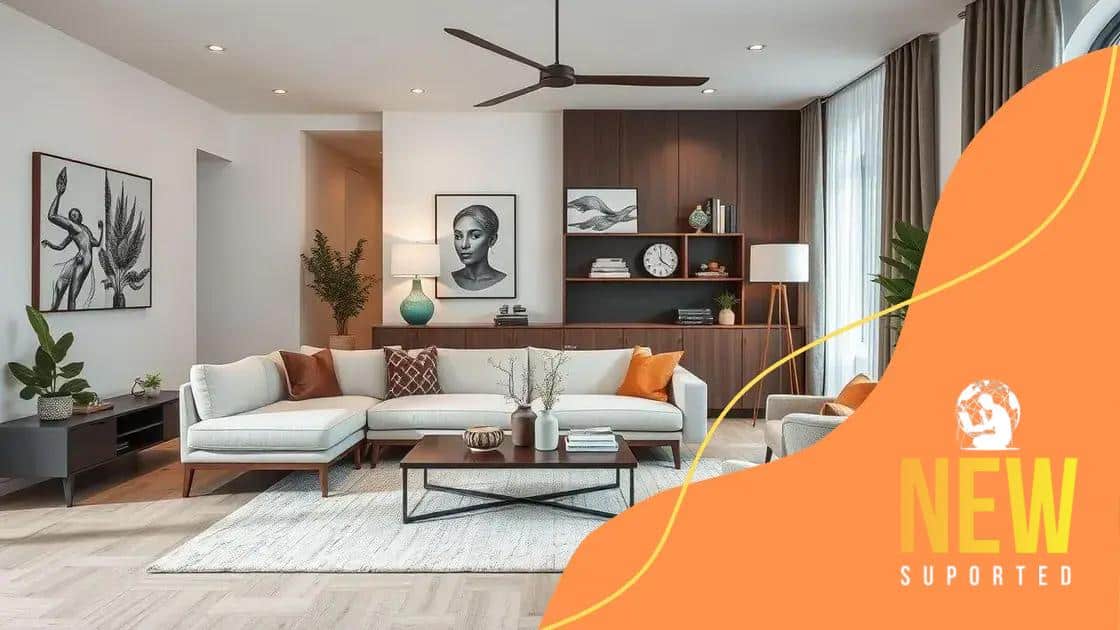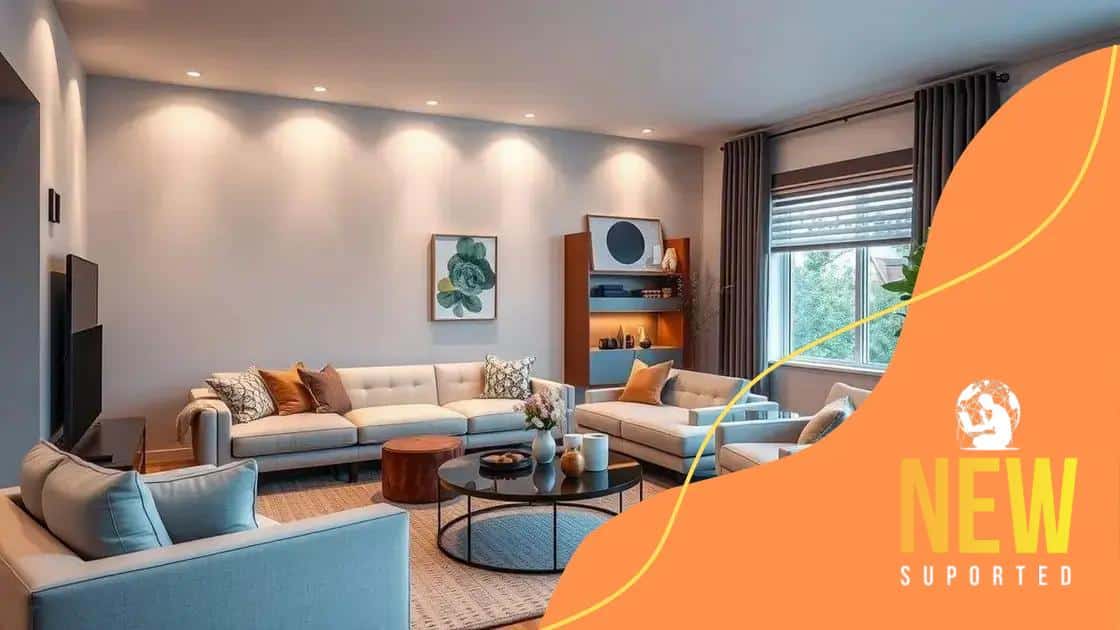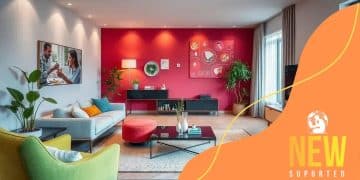Interior design trends in home decoration for 2025

Interior design trends in home decoration for 2025 focus on sustainability, flexible spaces, smart technology, and personalization through unique art, creating homes that are both functional and reflective of individual styles.
Interior design trends in home decoration for 2025 are evolving rapidly, blending functionality with aesthetics. Curious about what styles will dominate? Let’s dive into fresh ideas that can transform your home.
Embracing sustainable materials
As we look towards 2025, sustainable materials are becoming a vital part of interior design. The push for eco-friendly choices is reshaping home decoration. Homeowners are more aware of their impact on the planet, and this awareness drives the demand for greener materials.
Why Choose Sustainable Materials?
Opting for sustainable materials not only benefits the environment but also enhances the aesthetics of your home. Using products like bamboo, reclaimed wood, and recycled metals can create beautiful, lasting designs.
- Bamboo is renewable and sturdy.
- Reclaimed wood adds character and history.
- Recycled metals provide a modern touch.
- Natural fibers like jute and hemp are biodegradable.
Incorporating these materials is easier than ever as manufacturers are responding to the demand. Look for items that are certified organic or labeled as sustainable.
Designing with Sustainability in Mind
When designing your space, think about how materials influence the atmosphere. For instance, using natural wood can evoke warmth, while metal accents add a sleek, modern feel. Eco-friendly paints and finishes reduce indoor pollutants, contributing to a healthier living environment.
Consider also the lifecycle of products you choose. Investing in high-quality sustainable items means you’re less likely to replace them often, reducing waste over time. The beauty of embracing sustainability is the story behind each object, connecting you to nature and mindful practices.
Finally, educate yourself about local sources. Supporting local artisans who use sustainable methods not only enriches your home but also boosts your community. Together, we can create a positive ripple effect by favoring environmentally conscious choices.
Color palettes to watch
In 2025, the color palettes embraced by interior designers are all about evoking emotions and creating connections. These colors reflect current trends and our desire to feel at home in our spaces. Understanding these palettes can help you elevate your home decor.
Emerging Color Trends
This year, we are seeing a rise in bold, vibrant shades. These colors are used to create focal points within a room. Some popular choices include deep greens and rich blues, both of which bring a calming effect.
- Deep emerald green adds a touch of nature.
- Rich navy infuses elegance and depth.
- Bright coral injects energy and warmth.
- Soft lavender promotes serenity and balance.
Alongside vibrant tones, we also see a strong presence of muted hues. These shades provide a backdrop that allows other decor elements to shine.
Combining Colors Effectively
Mixing colors is essential to create harmony in your home. Think about complementary colors that can enhance each other. Pairing a soft beige with a bold teal can create a striking contrast that feels balanced.
Textures play a crucial role in how colors are perceived. A matte finish can soften a bright hue, while a glossy surface can amplify its vibrancy. Don’t hesitate to experiment with different finishes to achieve the desired look.
Additionally, incorporating nature-inspired colors helps create a seamless indoor-outdoor connection. Integrating earthy tones along with greens and browns can promote a sense of calm and stability.
Ultimately, your choice of color palette should reflect your personality and lifestyle. By choosing shades that resonate with you, you create a space that is both stylish and truly yours.
Smart technology in home decor

Smart technology is becoming an integral part of home decor in 2025. It not only enhances convenience but also elevates the style of your living spaces. Imagine controlling lighting, temperature, and even security with just a tap or a voice command!
Innovative Smart Devices
As technology advances, a variety of smart devices are emerging to complement our interiors. These devices seamlessly blend into your home while offering functionality. For example, smart speakers can double as stylish decor while providing music and control over other smart devices.
- Smart thermostats are energy-efficient and can be stylishly incorporated.
- Smart lighting fixtures allow you to change colors and intensity, setting the mood.
- Smart mirrors can display information while serving as a functional element in your bathroom.
- Automated window treatments are both practical and chic.
Integrating these technologies can transform a mundane space into a futuristic haven. As you consider these options, think about how they align with your personal style.
Designing with Technology
When incorporating smart technology into your decor, choose designs that match the aesthetic of your home. For instance, if you prefer a minimalist approach, look for sleek devices that do not disrupt your decor. On the other hand, vintage-style smart bulbs can give a charming twist to classical interiors.
Moreover, it’s essential to consider how technology can enhance your daily experience. Smart home systems can learn your routines and adjust settings automatically. This sets the stage for a comfortable and welcoming environment.
As we embrace these innovations, the key is to strike a balance between functionality and style. Smart technology should serve as a tool to elevate your home, not compromise its overall design. Thus, selecting the right devices and integrating them thoughtfully can lead to a harmonious and modern living space.
The rise of flexible spaces
The concept of flexible spaces is gaining momentum in home design for 2025. As our lifestyles change, so do our needs for our living environments. This trend emphasizes adaptability, allowing areas in the home to serve multiple purposes.
What are Flexible Spaces?
Flexible spaces can be adjusted to meet various demands, from working at home to hosting guests. Instead of having rooms dedicated to a single function, homeowners are looking for designs that allow fluid transitions between activities.
- Multi-functional furniture, such as sofa beds and foldable tables, maximizes usability.
- Open floor plans create a more inviting flow.
- Movable partitions can transform a large area into smaller, private zones.
- Convertible spaces help to balance work and leisure seamlessly.
This versatility not only enhances functionality but also adds an element of creativity to home decor. When designing these spaces, consider how you prioritizing elements can impact the overall flow of your home.
Design Ideas for Flexible Spaces
Implementing flexible spaces requires thoughtful design choices. Consider using furniture that can be easily rearranged based on your current activities. For example, a sturdy dining table can double as a workspace, creating a seamless transition from meals to meetings.
Additionally, utilize decor that encourages versatility. Accessories like ottomans can provide extra seating or serve as storage. Choosing colors and materials that are easy to clean and maintain will keep your flexible spaces practical.
As lifestyle trends continue to evolve, the demand for adaptable spaces will only grow. Embracing this flexibility can lead to a home that is efficient, stylish, and perfectly suited to your needs.
Art and personalization in design
In 2025, art and personalization in design is more important than ever. Homeowners are looking to express their unique styles through art and customized decor. This trend allows for a personal touch that makes every space feel special and lived in.
The Role of Art in Home Decor
Art plays a crucial role in adding character to any room. Whether it’s a large canvas or a collection of smaller pieces, art can reflect your personality. Choosing artwork that resonates with you allows your home to showcase your story.
- Local artists can offer unique pieces that support the community.
- Mixing different styles can create visual interest.
- Artwork should evoke emotions or provoke thought.
- Consider the color scheme of your art to complement your decor.
Moreover, the way you display art can make a significant difference. Frames, mounts, and the arrangement all contribute to the overall aesthetic. Consider creating a gallery wall for a bold statement.
Personalization in Design
Personalization goes beyond art. It encompasses everything from furniture choices to decorative elements. Use items that represent your experiences, such as travel souvenirs or family heirlooms.
Custom furniture options are on the rise, allowing you to select materials, colors, and designs that fit your vision. Personal touches like monograms or custom-made pieces can turn a simple room into a home.
Finally, don’t overlook the importance of textiles. Choose fabrics that reflect your taste, whether it’s luxurious velvet or casual cotton. These elements contribute to the overall feeling of your space. In 2025, the blend of art and personalization will help create homes that feel authentic and inviting.
FAQ – Frequently Asked Questions about Interior Design Trends in 2025
What are the key trends in interior design for 2025?
Key trends include sustainability, flexible spaces, smart technology, and personalization through art.
How can I incorporate sustainability into my home decor?
You can use eco-friendly materials, such as reclaimed wood, natural fibers, and energy-efficient appliances.
What does flexibility in home design mean?
Flexibility refers to the ability of spaces to serve multiple purposes, allowing for easy adaptation based on needs.
How can I personalize my home decor?
You can personalize your space with art, custom furniture, and meaningful decorative items that reflect your style.






